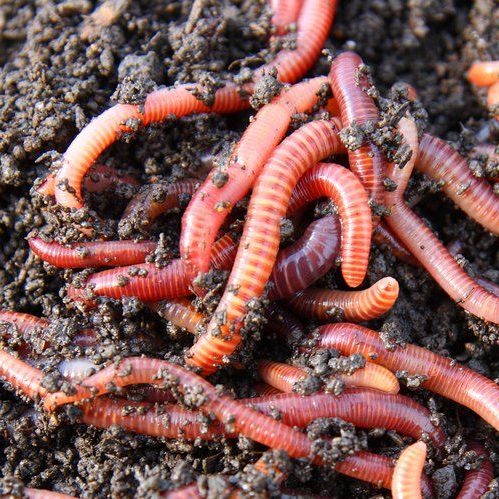Unlock the Tricks of Red Wigglers: Your Guide to Composting Success
The combination of red wigglers into composting techniques offers a substantial possibility for improving soil health and advertising sustainability. These organisms are not just reliable recyclers of natural waste; they use a myriad of advantages that can transform garden management. Recognizing their needs and actions is essential for maximizing their capacity, from establishing an appropriate worm bin to feeding them the best products. As we explore the necessary parts of successful vermicomposting, one might ask yourself just how these little creatures can cause a more vibrant and effective yard ecological community.

What Are Red Wigglers?
(Lake Hickory Bait)Red wigglers, medically referred to as Eisenia fetida, are a varieties of earthworm largely used in composting because of their impressive capacity to break down organic matter efficiently. These worms are identified by their reddish-brown pigmentation and a segmented body, normally gauging in between 3 to 4 inches in size. Unlike other earthworm types, red wigglers flourish in abundant, natural atmospheres, making them optimal for vermicomposting systems.
Belonging To North America, they are usually discovered in decomposing leaves and compost piles, where they play an important role in nutrient recycling. Their adaptation to living in a moist, cardiovascular setting allows them to take in large quantities of organic waste, simplifying into nutrient-rich castings that improve dirt health.
Red wigglers reproduce quickly, with a solitary worm qualified of producing numerous cocoons weekly, each having multiple hatchlings. This fast reproduction rate adds to their effectiveness in composting procedures. They favor temperature levels in between 60 ° F and 80 ° F, and their activity degree boosts considerably within this array, more helping in the disintegration process. Comprehending the biology and habits of red wigglers is essential for maximizing their capacity in composting applications.
Advantages of Making Use Of Red Wigglers
Using the power of red wigglers in composting provides various advantages that improve soil health and wellness and promote lasting waste management. These exceptional microorganisms successfully damage down organic issue, changing kitchen scraps and yard waste into nutrient-rich vermicompost. This finished item is exceptionally useful for plant growth, as it improves soil structure, raises moisture retention, and boosts nutrition availability.

(Lake Hickory Bait)In addition, the presence of red wigglers in your composting system can speed up the composting process, creating high-grade garden compost in a fraction of the moment contrasted to conventional methods. The castings produced by these worms are likewise bursting with useful microorganisms that additionally enrich the dirt ecological community.
Establishing Your Worm Container
Developing an effective worm bin is an uncomplicated process that can considerably enhance your composting initiatives. Worm containers can be made from plastic storage space bins, wood boxes, or readily offered worm containers.
Following, prepare the bedding product, which offers as the worms' habitat. A mix of shredded paper, cardboard, and coconut coir functions well, offering a comfy environment for the worms.

Feeding Your Red Wigglers
To make certain the health and wellness and efficiency of your red wigglers, it is important to give them with a well balanced diet regimen that satisfies their nutritional requirements. Red wigglers thrive on a varied variety of organic materials, which not just supply necessary nutrients but likewise promote efficient composting.
Begin by including kitchen scraps such as vegetable peels, fruit cores, and coffee grounds. Avoid citrus fruits, onions, and garlic, as these can be harmful to worm health. Additionally, present shredded paper, cardboard, and dry leaves to create a well-aerated atmosphere.
Feeding regularity must be monitored; usually, worms can consume half their body weight in food weekly. It is critical to stay clear of overfeeding, as excess food can cause unpleasant smells and attract parasites. A good practice is to add food in percentages, enabling worms to refine it prior to introducing extra.
Keeping moisture levels is additionally important; the bedding must perspire yet not soaked. Last but not least, be sure to regularly check the temperature level and pH degrees of the container to guarantee an ideal environment for your red wigglers, eventually enhancing their composting performance.
Harvesting and Utilizing Compost
An effective composting process with red wigglers culminates in the rich, dark compost referred to as vermicompost, which can significantly improve soil health and plant growth. Collecting this nutrient-dense material generally takes place every 3 to six months, depending on the dimension of your system and the amount of raw material being refined.
To gather, carefully different the compost from the worms and any undecomposed products. One effective method involves relocating the components of the container to one side and including fresh bed linens and food to the void, urging the worms to migrate. After a couple of days, the compost can be accumulated from the opposite side.
It is important to make use of vermicompost correctly to maximize its advantages. It can be used as a leading clothing for yard beds, combined right into potting dirt, or brewed right into a nutrient-rich liquid fertilizer called "worm tea." This application approach helps to deliver crucial nutrients directly to plant origins, promoting healthier development. By integrating vermicompost into your horticulture regimen, you not only reuse natural waste but additionally develop a growing environment that sustains sustainable gardening techniques.
Conclusion
In summary, red wigglers act as phenomenal allies in composting efforts, transforming organic waste into nutrient-rich vermicompost (Red Wiggler Express). Their one-of-a-kind organic qualities and effective waste processing abilities add considerably to lasting horticulture practices. By comprehending the optimum problems for their habitat, feeding requirements, and garden compost harvesting methods, gardeners can improve soil health and wellness and promote plant vitality. Accepting vermicomposting not only lowers landfill waste but likewise cultivates an extra environmentally responsible strategy to horticulture and resource administration.